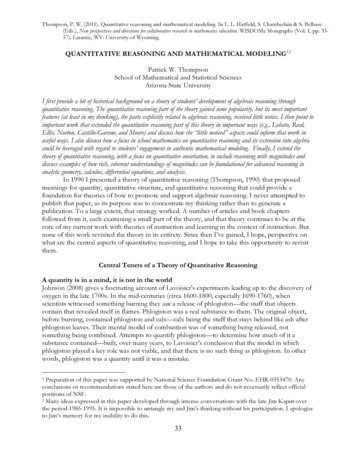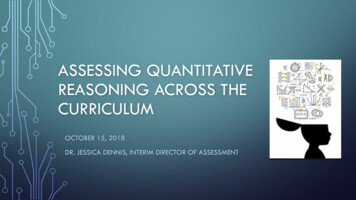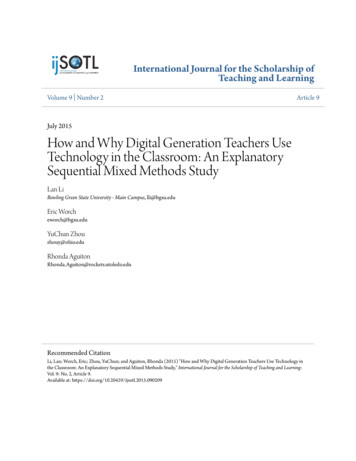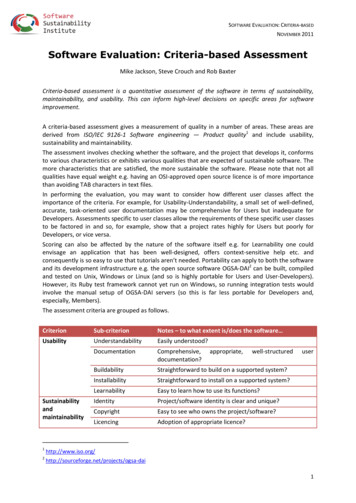
Transcription
ASSESSMENT OF DIGITAL EEG, QUANTITATIVEEEG, AND EEG BRAIN MAPPINGReport of the American Academy of Neurology and theAmerican Clinical Neurophysiology Society*Digital EEG techniques have grown rapidly in popularity for recording, reviewing, and storing EEG. Digital EEGrecordings are flexible in the way they display the EEG tracings, unlike analog paper EEG. Montage, filter, andgain settings can be changed retrospectively during record review. Quantitative EEG (QEEG) analysis techniquescan provide additional measurements or displays of EEG in ways not available with analog paper EEG recordings.Several QEEG techniques, commonly called “EEG brain mapping,” include topographic displays of voltage orfrequency, statistical comparisons to normative values, and discriminant analysis. Although much scientificliterature has been produced after decades of research in this field, there remains controversy about the clinical roleof QEEG analysis techniques. This assessment is meant to help the clinician by providing an expert review of thecurrent clinical usefulness of these techniques.Evaluation process. Previous assessments on this subject were published by the American Electroencephalographic Society (American EEG Society, AEEGS) in 1987 and by the American Academy of Neurology(AAN) in 1989.1,2 Members of both societies were notified by newsletter to solicit their opinions with supportinginformation for this assessment. Commercial digital EEG vendors were identified by their participation in societymeeting exhibits or by their known interests in this field, and they were asked to submit relevant scientificpublications supporting clinical use. Many experts in the field were also contacted to request their opinions and tocite relevant scientific publications. A literature search was conducted using the Medline database, covering theyears 1984-1995. Searched topics included EEG and evoked potentials, among others, and the identified citationswere manually screened for relevance to this assessment. Review articles and published literature reference sectionswere also screened for relevant information. When outside reviewers and other experts presented viewpoints differing from circulated drafts of this assessment, their opinions and relevant cited literature were reviewed and anyappropriate changes were made in the assessment.In assessing the literature, clinical assessment criteria should include several ideal elements andconcepts3-32: The disease studied should be clearly defined. Criteria for test abnormality should be definedexplicitly, clearly, and prospectively. Control groups should be used, including normal controls as well as patientswith other diseases in the common differential diagnosis of the disease tested. The control groups should bedifferent from those originally used to derive the test's normal limits. The severity of disease should simulate theseverity in patients for which the use of the test is proposed. Test-retest reliability should be high. Variousassessments of validity should be measured, e.g., sensitivity, specificity, positive predictive value, and negativepredictive value. Validity measures for the evaluated test should be compared to such results obtained with othertests already clinically used in that differential diagnosis, including diagnosis based on signs and symptoms, routineEEG, or neuroimaging tests. Blinded observations were considered a more objective, preferred measure of a test'svalidity. Medical efficacy was evaluated in several ways. An effective test may reduce morbidity or mortality byclarifying which medical intervention is best. It may substitute a less risky test for one with greater medical complications. It may substantially clarify a diagnosis, leading to more accurate prognosis, or improved expectations andbehavior. Incremental changes to already accepted tests and applications require less proof through new studies,whereas novel techniques and applications require a greater degree of demonstration of validity and utility.A panel of experts, jointly appointed by the American Clinical Neurophysiology Society (ACNS, formerlythe American EEG Society) and the American Academy of Neurology, reviewed and summarized the relevantliterature. The assessment cites some of the reviewed literature, but does not attempt to cite all QEEG literaturecomprehensively here. Specific panel members reviewed individual topics in detail as well as drafts of the overallassessment. Scientific evidence was weighed based on the classes of evidence, including criteria elements describedabove. Strengths of recommendations were based on quality and consistency of the clinical scientific evidence as
Digital EEGPage 2well as the magnitude of the medical efficacy and costs. Possible conflict of interest by study authors was alsoconsidered in cases where the authors were involved in commercializing their techniques.Eventually a draft of this assessment was circulated to many experts in the field, a group of practicingneurologists, and other societies. Their advice about the assessment was taken into consideration in preparation ofthe final draft of the document.Various gold standards were considered, depending on the clinical question for which a test was beingevaluated. This assessment covered a wide variety of clinical settings. QEEG is inseparably bound together withroutine EEG. These two often needed to be considered together for the purposes of the assessment, sometimesspecifically assessing whether QEEG offers net advantages over routine EEG in existing diagnostic paradigms.Where routine EEG is not now a part of the usual diagnostic evaluation, the results of QEEG studies were compared against the existing standards for those diagnoses, e.g., using signs, symptoms, neuroimaging results, etc.General comments and nomenclature. Terms in use in this field include “digital,” “paperless,” and “quantitativeEEG” as well as “EEG brain mapping.” The table describes relationships among these various terms.I. Digital EEG is the paperless acquisition and recording of the EEG via computer-based instrumentation,with waveform storage in a digital format on electronic media, and waveform display on an electronic monitor orother computer output device. The recording parameters and conduct of the test are governed by the applicablestandards of the ACNS guidelines and are identical to or directly analogous to those for paper EEG recordings.33Table Nomenclature for digital and quantitative EEGDigital EEGQuantitative EEG (QEEG)Signal analysisAutomated event detectionMonitoring and trendingSource analysisFrequency analysisTopographic displays (“brain maps”)Statistical analysisComparisons to normative valuesDiagnostic discriminant analysisIdeally, digital EEG creates a recording on a digital medium without loss of anything except the paperitself. In practice, there may be some loss of detail especially at the lower sensitivity settings. Digital EEG alsoallows for simple but extremely useful digital utilities such as post hoc changes in filters, horizontal and verticaldisplay scale, and montage reformatting that allow greater flexibility in reading the EEG. These tools allow forbetter visual reading of the record than can be achieved with an analog paper record. Network storage allows accessfrom remote sites. New improved derived references can be calculated and used, and very large numbers ofrecording channels can be processed and managed.34 Digital EEG is an excellent technical advance and should beconsidered an established guideline for clinical EEG.II. Quantitatiue EEG (QEEG) is the mathematical processing of digitally recorded EEG in order tohighlight specific waveform components, transform the EEG into a format or domain that elucidates relevantinformation, or associate numerical results with the EEG data for subsequent review or comparison.II.A. Signal analysis is the quantitative measurement of specific EEG properties or a transformation of theraw, digitally recorded EEG signal into numerical parameters other than the traditional amplitude versus time.Several types of measurements or analyses can be made.II.A.1. Automated event detection is the use of mathematical algorithms to detect or identify events orabnormalities that the computer has been instructed to bring to the attention of medical personnel. No alteration ismade in the raw EEG data, except optional data compression. This is used typically in long-term EEG recordingsfor spike and seizure detection.II.A.2. Monitoring and trending EEG. This technique uses mathematical algorithms to extract parametersfrom the raw data that summarize the important aspects of the EEG. The medical personnel can then be presentedwith simplified graphical displays of these trended parameters. Alterations of the trends may prompt the users toreview in detail specific portions of EEG data. This is used typically in neurophysiologic monitoring applications in
Digital EEGPage 3the OR or ICU.II.A.3. Source analysis is a form of mathematical analysis in which the recorded EEG values (typicallyscalp voltage values from an epileptiform abnormality) are compared with predetermined models of possible EEGgenerators. The analysis may specify the location, orientation, strength, and number of the possible sources of theanalyzed spike or other EEG feature.II.A.4. Frequency analysis converts the original EEG data into a representation of its frequency content.The magnitude corresponds to the amount of energy that the original EEG possesses at each frequency. Anexample of the use of frequency analysis is to look for evidence of excess slow activity. Coherence analysis usescalculations similar to frequency analysis to obtain information about the temporal relationships of frequencycomponents at different recording sites, typically for evaluation of seizure origin. The results of signal processing,such as frequency analysis, may be displayed as a table of numbers, a multidimensional graph, or a topographicdisplay (see below).II.B. Topographic EEG displays can present visually a spatial representation of raw EEG data (i.e.,voltage amplitude) or a derived parameter (e.g., power in a given frequency band, or peak latency). Typically, theparameter under study is mapped onto a stylized picture of the head or the brain, but may be mapped onto ananatomically accurate rendering of the brain, such as a three-dimensional volume-reconstructed MRI. Amplitude ata given anatomic site is ordinarily represented as a color or intensity, and amplitudes at unmeasured sites areinterpolated to present a smooth display. These displays can highlight some spatial features of the EEG. Theserepresentations are often collectively referred to as EEG brain maps. This term, in this context, should not beconfused with functional cortical brain mapping by direct electrical cortical stimulation or with brain mapping byneuroimaging techniques, which have no direct relationship to EEG brain mapping.II.C. Statistical analysis compares variables derived from the digitally recorded EEG between groups ofpeople or between a patient and a group. These comparisons may be carried out on individual variables (e.g., thealpha frequency) or on many variables using appropriate multifactorial statistical methods. Spatial aspects may beincluded, e.g., by statistical comparison of topographic EEG maps.II.C.1. Comparison to normative values uses group statistics to determine whether a parameter (or parameters) measured on an individual patient lies inside or outside the range of normal values. Statistical techniquesemployed may be simple thresholds based on the mean and standard deviation of a “normal" distribution. Moreadvanced techniques may encompass age-adjusted norms, bayesian statistics, etc.II.C.2. Diagnostic discriminant analysis gathers selected parameters for several different patient diagnostic subgroups, as well as for controls. A discriminant function can be mathematically determined that ascribescertain patterns of these parameters to each patient group. The technique then compares the pattern of the EEGparameters derived from one patient to all of the relevant patient groups to determine with which diagnostic groupthe patient's EEG is statistically most closely associated.Problems. Despite such potential advantages, QEEG's clinical usefulness is now quite limited, although ithas substantial potential for future applications. At this time, most scientific reports more convincingly havedemonstrated research applications rather than clinical applications. Among the reports suggesting clinical utility,few have been prospectively verified or reproduced, and some conflict with others. Techniques used in QEEG varysubstantially between laboratories, and any clinical usefulness found with one specific technique may not applywhen using a different technique. Many technical and clinical problems interfere with simple clinical application.Traditional EEG artifacts can appear in unusual and surprising ways, and new artifacts can be caused by thedata-processing algorithms. Some artifacts, such as eye movements, are common in the EEG, and even subtle oneswill produce highly significant QEEG abnormalities if they go unrecognized. Abnormal activity such asepileptiform spikes may be overlooked, considered artifactual, or misinterpreted. Transient slowing can be missed.The computer may score as “abnormal” some EEG activity known to have no clinical importance, such as mu, orslow alpha variant.Automated assessment of normality must take into account the subject's age, state of alertness, and otherfacts. But, ways to accomplish this are not yet well defined in any way that has been widely accepted orconsistently applied. These problems are compounded when the patient is receiving medication that alters the EEG.Substantial unresolved statistical issues are critical in automated assessment of normality. Because of theseproblems, EEG brain mapping and other QEEG techniques are very predisposed to false-positive errors, i.e.,erroneously identifying normal or normal variant patterns as “abnormalities.” Experienced users are aware of theseproblems, which represent challenges especially for less-experienced interpreters. These difficulties have beenreviewed elsewhere, along with the controversy about their impact on potential clinical utility.35-57Prospective evaluation of EEG discriminant analysis has not yet demonstrated its practical use in clinical
Digital EEGPage 4differential diagnosis. Some studies have shown very interesting positive results, but these still await prospectiveassessment of clinical utility. Substantial variability in EEG features occurs among normal subjects as well asamong patients with specific disorders, so that the discriminant matching of EEG features may be very difficult inpractice. Mistaken diagnoses can readily occur in such QEEG discriminant analyses.58 When drowsiness occurs, orif the patient is taking certain medications, the tests are invalid. Drowsiness can mimic disease in EEG or QEEG.Even well-established routine EEG abnormalities such as focal slowing are generally nonspecific as to cause ordisease.A common mistake occurs when running a large battery of QEEG tests, sometimes encompassinghundreds or even thousands of individual statistical assessments on one patient. In this setting, many statisticallypositive “abnormalities" will occur by chance alone in normal subjects. These false-positive “abnormalities”average about 5% of the number of statistical tests run in some applications, but can reach 15 to 20% in someindividual normal control subjects.59 Many changes seen statistically are generally now regarded as clinicallymeaningless, e.g., diffusely decreased delta or increased beta. Others are controversial and still have nowell-established clinical role, e.g., changes in coherence. Some retrospective and statistical analyses of coherencehave shown interesting, positive results that await prospective validation in clinical practice. Given the complexityof studies or tests with very large volumes of statistical testing, some of these problems may be avoided by usingQEEG techniques to ask a few specific measurement questions that are likely to be clinically meaningful, e.g., tolocalize or identify increases in slow-wave activity.Many common QEEG mistakes have been reviewed by Duffy et al.,46 along with recommendations forcontrolling some of the difficulties. That review expresses some overly optimistic opinions about the clinical utilityof QEEG. In general, the review's many specific technical suggestions and precautions are quite appropriate.Visual and auditory long-latency evoked potentials have also been used along with EEG brain mappingtechniques.60-81 At present, insufficient information is available about evoked potential topographic mapping andstatistical normative scoring to assess its normal variants, normal limits, effects of medication, and other relevanttechnical and patient-related factors. No well-designed, prospectively verified clinical studies have demonstratedthe clinical utility of topographic mapping of long-latency evoked potentials for diagnosis in clinicalsettings. When statistical methods (e.g., z-scores) do detect changes in topographic maps of long-latency EPamplitudes, the reader may not be able to differentiate between chance events, normal variants, and true pathology.Overall, the problems of QEEG were weighed against its positive values. In some circumstances, QEEGhas some positive values, but they are outweighed by the substantial problems encountered in trying to use the testsclinically. In other circumstances, QEEG's positive values outweighed its disadvantages, leading to positiverecommendations for use. In the latter case, these positive values outweigh the technique's problems only whenused in expert hands and with good clinical judgment.Clinical settings. Epilepsy. Routine EEG is an established test commonly used in the clinical evaluation ofpatients with epilepsy. EEG testing can help to locate an epileptic focus or suggest the type of epilepsy. SomeQEEG methods have built on that established role. Routine EEG, EEG brain mapping, and other QEEG techniquescannot diagnose whether a patient has epilepsy.Spike and seizure detection. Digital spike and seizure detection can identify candidate events that mightbe epileptic spikes or seizures, although frequent false-positive detections occur The clinical use of any spike orseizure-detection algorithm must balance sensitivity against specificity. In long-term EEG monitoring records ofoutpatients, inpatients, or ICU patients, candidate spikes or seizures are selected automatically and saved forsubsequent professional visual review and confirmation. This data reduction method is a valuable time-saving tool,especially in recordings lasting one or several days. Studies 82-104 include multiple well-designed, controlled studiescomparing digital detection to detection by visual review as the standard. Sensitivities were often better than 80 to90%, although specificity remained poor. The clinical rationale seems clear. General clinical use in the communityhas been very positive.Such monitoring and automated seizure detection can also identify nonconvulsive seizures occurringamong ICU patients at risk for such complications, prompting early clinical intervention.98-l00,l05 For ICU patientsrequiring neuromuscular blockade while intubated, EEG monitoring may be the only way to detect convulsivestatus epilepticus.106 Nonconvulsive seizures can also present with a diminished state of consciousness, potentiallymimicking other types of encephalopathy.l07-ll3Spike dipole analysis. Quantitative analysis of the spatial and temporal character of spike voltage fieldsand subsequent equivalent dipole modeling can suggest the location of the cortical generators, the presence and
Digital EEGPage 5direction of propagation, and the existence of multiple separate spike sources. While sometimes available fromroutine visual review of EEG traces, this information can be estimated more confidently by combining visualreview with voltage mapping and source modeling of individual or averaged spikes. Although dipole solutionsobtained are not mathematically unique and the localization is not anatomically precise, these techniques appearuseful in the noninvasive evaluation of candidates for epilepsy surgery. In particular, certain characteristic scalpvoltage fields of epileptic spikes and ictal discharges are likely to have a mesial-basal temporal source, whereasother fields are likely to have a lateral temporal cortical origin.114-121 If a sufficient area of the mesial-basal temporalcortex is involved in generating a spike discharge, the discharge can be recorded at the scalp whereas smallermesial-basal spike discharges may not be accompanied by distinguishable scalp fields.l22 Caution must be exercisedbecause erroneous localization can occur even for experienced users due in large part to the simplified sphericalhead model commonly used.l23 The well designed studies of this specific technique are few but consistent andconfirmed in follow-up postoperatively. The clinical rationale seems clear. Control testing for evoked potentialknown cortical generator sites has confirmed the technical accuracy of dipole localization. The use of dipoleanalysis seems sufficiently demonstrated to warrant its clinical use in patients undergoing evaluation for surgicaltherapy for epilepsy.In other clinical settings, it has not been demonstrated to be sufficiently clinically useful to warrant generalclinical use at this time. In benign rolandic epilepsy of childhood (BREC), quantitative spike voltage analysis candetermine field complexity and dipole model stability. These data have shown diagnostic value in differentiating“typical” from “atypical” BREC and complex partial epilepsy, a distinction that carries substantial prognostic andtherapeutic significance.l24-127 Here, though, the clinical use is somewhat unclear overall. Further follow-up studiesseem warranted on these other uses of dipole analysis, to clarify the prospective clinical utility and the reliableimpact, if any, on patient care management or counseling.Secondary bilateral synchrony. Some quantitative techniques can help differentiate primary generalizeddischarges from secondary bilateral synchrony by looking for small, reproducible interhemispheric timingdifferences in such discharges and the characteristic distribution of maximal activity.l28-l32 This differentiation mayhelp guide the choice of the best antiepileptic medication as well as aid presurgical localization. This potentiallyuseful application has not yet been demonstrated to be sufficiently clinically useful to warrant general clinical use.Frequency analysis and fast activity. Regional or focal EEG slowing or diminished fast backgroundactivity has long been valued as a means to help lateralize an epileptic focus. Quantitative frequency analysis canoccasionally identify and lateralize or localize EEG features that are subtle and might be overlooked on routinevisual EEG inspection.7l,72,l33-137 Attempts to use evoked potentials for lateralization have met with mixed success,and this is not yet sufficiently reliable for routine clinical use.7l-72,l38 In recordings from implanted electrodes, digitalEEG with a high sampling rate and high filters above 150 Hz can highlight very high frequency actinity,139-l4l whichcan be difficult to detect on traditional paper EEG recording. Interpretation of these slow and fast rhythms wouldbe considered a part of the interpretation of the digital EEG per se, rather than a separate diagnostic procedure.Overall, on the basis of Class II evidence and several Class I studies, QEEG is considered an establishedadjunct to digital EEG for screening for possible spikes or seizures in long-term monitoring and ambulatoryrecording, to facilitate subsequent expert visual EEG interpretation.QEEG topographic voltage analysis with dipole analysis may be useful in pre-surgical evaluations as anaddition to digital EEG (Class II evidence, as a possibly useful test).Cerebrovascular disease. In cerebrovascular disease, several EEG frequency parameters are highlycorrelated with regional blood flow or metabolism. When used by skilled professionals experienced in EEGinterpretation, sensitivity and specificity are high for detection of ischemia-related cerebral impairment or similarfocal impairment.l42-157 These studies show sensitivity generally greater than 80% with good specificities,false-positive rates below 5 to 10%, and correlations of r 0.7 between EEG and blood flow in ischemic andnonischemic regions. Many were controlled, well-designed studies, some of which were prospective and blindedand which showed that QEEG could detect reliable focal features that were missed on initial visual review of theroutine EEG. These tests can be quite abnormal even when the CT is still normal, such as in the first 1 to 3 daysafter stroke or when the degree of ischemia is mild enough to cause dysfunction without infarction. However, EEGanatomical localization is very much inferior to that found with CT or MRI. As with routine EEG, QEEG changesare unable to differentiate infarction from hemorrhage, tumor, or other focal cerebral lesions.158 Little has beenpublished on how these QEEG tests could affect the diagnosis or treatment of individual patients. For most patientswith cerebrovascular disease, CT or MRI remains the test of choice. In general, therefore, QEEG has no clearmedical indication in evaluations of patients with cerebrovascular disease when MRI, CT, and routine EEG arealready available but are nonlocalizing or noncontributory. Exceptions warranting possible EEG, with or without
Digital EEGPage 6QEEG, are certain patients for whom MRI or CT is not available in their community; or patients who are too ill totravel to a neuroimaging location; or patients in whom the neuroimaging tests are nonlocalizing, but substantialclinical suspicion of focal cerebral dysfunction remains. EEG is clinically warranted among some cerebrovasculardisease patients who have additional clinical problems or complications such as coma or possible seizures.Based on Class II and III evidence, QEEG in expert hands may possibly be useful in evaluating certainpatients with symptoms of cerebrovascular disease whose neuroimaging and routine EEG studies are notconclusive (Type B recommendation).Monitoring in the OR and ICU. In continuous OR or ICU monitoring, such as during carotid endarterectomy, continuous trending of EEG frequency analysis may supplement routine EEG to identify and to measureclinically meaningful changes more reliably.159-161 Trending can graphically demonstrate physiologic changes in away that is sometimes easier to appreciate, especially when seeking gradual change over very long time periods.For ICU patients at high risk for ischemic stroke, acute intracranial bleed, vasospasm, critically elevatedintracranial pressure (ICP), or related ischemia, continuous monitoring of EEG has been used. Monitoring canidentify complications in time to initiate therapy, thereby preventing some long-term neurologic sequelae. It canalso provide feedback on therapy, allowing titration of barbiturates given for deliberate burst-suppression,antiepileptics given for nonconvulsive status, mannitol given for increased ICP or other therapeutic interventions.Quantitative monitoring may also help to separate variable-reactive EEG from monotonous-nonreactive EEG,thereby substantially enhancing accuracy of prognosis. In the ICU, such EEG monitoring often uses frequencyanalysis trends to supplement the routine analog or digital EEG collection, allowing quick identification of changesfrom trends while retaining the original digital EEG tracings for interpretation by an experienced EEG reader. Suchuses have been verified in several large prospective trials and other studies.98-100,162-183 Many of these arewell-designed studies clearly demonstrating clinically useful results not obtainable in any other way. Continuousmonitoring of the brain in this way is able to detect some types of common neuro-ICU complications, such asnonconvulsive status epilepticus or early ischemia, which would not be detected and diagnosed by occasional20-minute-long routine EEGs or careful clinical neurologic examination or neuroimaging tests. Long-termfollow-up studies demonstrated very substantial outcome differences predicted by EEG monitoring. The clinicalrationale for use of these techniques seems clear.On the basis of considerable Class II evidence, EEG seizure detection and frequency analysis is considered established as a practice option when used as an adjunct to routine or digital EEG for continuous brainmonitoring by frequency trending in the OR or ICU to detect early acute intracranial complications, and forscreening for possible epileptic seizures in high-risk ICU patients (Type B recommendation).Dementia and encephalopathies. In dementia evaluations, the finding of focal or generalized EEGbackground slowing does strongly suggest an organic basis rather than depression. QEEG parallels thelong-established role for routine EEG in the detection of diminished alpha and increased slowing in delirium anddementias. EEG frequency analysis sometimes allows confident detection of excess slowing to be appreciated andmeasured more readily than does routine EEG alone.184-208EEG frequency analysis tests cannot yet reliably distinguish between the types of dementia, in contrast tosome specific routine EEG wave patterns that are highly suggestive of certain encephalopathies or dementingdisorders. Most EEG changes in dementia can be seen on routine EEG testing, and so the additional clinicalusefulness of QEEG remains limited. The sensitivity of EEG, with or without frequency analysis, is high formoderate-to-severe dementi
itself. In practice, there may be some loss of detail especially at the lower sensitivity settings. Digital EEG also allows for simple but extremely useful digital utilities such as post hoc changes in filters, horizontal and vertical display scale, and montage reformatting that allow grea










